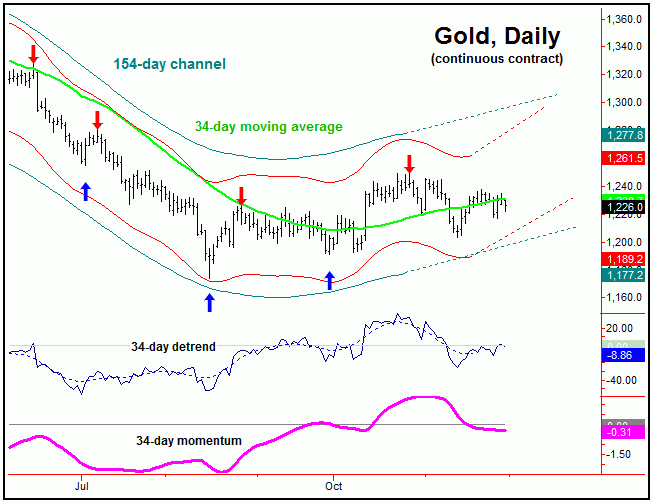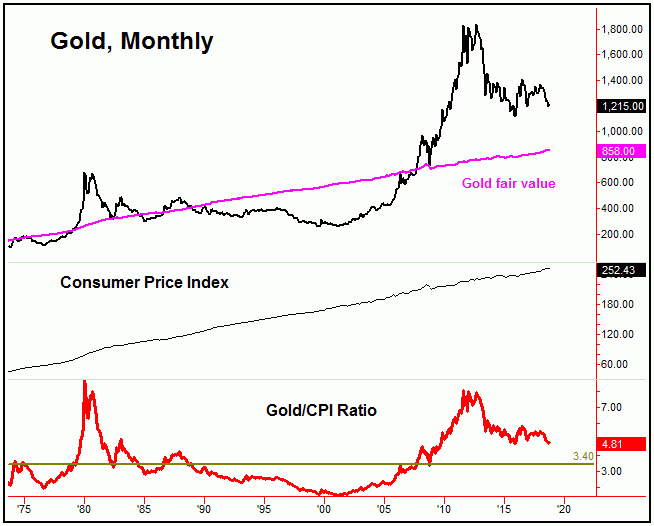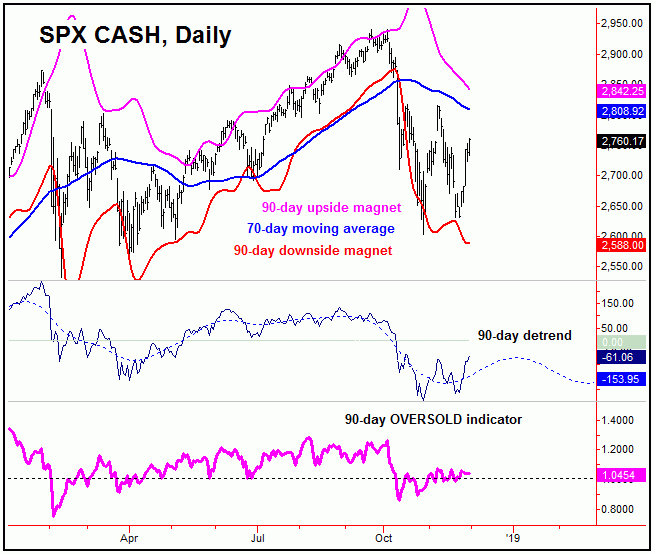Gold's Choppy Price Action And Stock Cycles Pointing Up

For the gold market, the recent action has been very choppy, with the short-term waves either having bottomed - or else with a marginal amount of weakness still to come. As for U.S. stocks, the cycles there are pointing higher into later this month, which is in line with the normal seasonal patterns - even though the move up off the late-October low is expected to end up as a countertrend affair.
Gold Cycles, Short-Term
As mentioned in my last article, the smallest cycle that we track - the nominal 10-day wave - was in topping range for gold. The action seen into early last week confirmed the downward phase of this wave to be back in force, which favored additional weakness, which we did see with Wednesday's tag of the 1211.40 figure (December, 2018 contract). From there, however, a reversal back to the upside was seen to end the week.
The chart above shows each of the past bottoms and tops with the 10-day wave. Heading into the new week, the question is whether this cycle has already troughed at Wednesday's low. Right now, there is no way to know, though any reversal back above the 1238.00 figure - now basis the February, 2019 contract - would be our best indication of the same. Otherwise, below that figure and the metal will remain weaker, still with the potential for lower lows.
Stepping back slightly, the larger 34 and 72-day cycles have been seen as heading south, ideally set to bottom into the late-November to early-December timeframe. Shown below is the smaller (and more dominant) 34-day component:
Going further with the above, any reversal back above the 1238.00 figure, if seen, would not only infer the 10-day wave to have troughed - but would also tend to favor the larger 34 and 72-day cycles to have also bottomed. If that were to end up as correct, then the probabilities would favor additional strength into the mid-to-late December timeframe or beyond.
Our 34-day cycle channel also shows how the action would be expected to play out in the coming weeks, should the upward phase of the 34 and 72-day cycles be confirmed to be back in force. In terms of price, that path would also put the 154-day moving average (around the 1253 figure) as the expected minimum magnet, though the larger swing up is anticipated to end up as an eventual countertrend affair.
Gold, Longer-Term
For the bigger picture, the overall assumption is that gold will see an eventual drop back to fair value, based upon the Gold/CPI ratio model (chart, above). That means an eventual drop back to the mid-to-high 800's - though I should quickly point out that this level is rising slightly as time progresses. In terms of time, however, there is no particular expectation for this drop back to fair value to occur. Once it does materialize, we will need to be on the lookout for technical indications of a completed bear market for the metal.
U.S. Stocks (Update)
In looking again at the U.S. stock market this weekend, the last swing bottom was made into late-October, doing so with the tag of the 2603.54 SPX CASH figure. That low was also a trough with our 45 and 90-day time cycles, with the upward phasing of these waves seen as in force off the same - but a move expected to end up as a countertrend affair.
In terms of price, as noted in a prior article, the 35-day moving average was the expected minimum magnet, and which was hit with the last rally up to the 2815 SPX CASH figure. Having said that, the ideal path would be for the index to make a tag of the 70-day moving average (chart, above), due to the configuration of the 90-day cycle. In terms of time, the best spot for this to occur should be sometime this month, the sooner the better.
Even with the near-term bullish indications for stocks, the favored path is for the upward phasing of the 90-day cycle to end up as a countertrend affair - which means that the SPX should remain below the 2940.91 swing top, seen back in late-September. If correct, then the next downward phase of that cycle (i.e., January or later) should be the one that bottoms the larger 180 and 360-day cycles, with the smaller (180-day) component shown on the chart above.
For the bigger picture, as long as the correction phase of the 180 and 360-day cycles is able to remain at a respectable level (which it has, at least thus far), the probabilities will favor a push back to new all-time highs into late-Spring of 2019 or later. If seen, that move would be the odds-on favorite to trough the even-larger four and nine-year cycles, with the smaller four-year wave shown on our next chart:
With the above said and noted, the next major peak is expected to come from the combination of the four-year and nine-year cycles, with the next downward phase of these waves currently projected to bottom around the Spring of 2020, but with a large plus or minus variance in either direction. The next correction phase of these waves is expected to see a minimum drop back to the 48-month moving average, though with a decent shot that a decline all the way back down to the lower 96-month average will be seen. For now, there is no confirmation that these waves have peaked, though this is something which we will be watching with a great deal of interest in the coming months. Stay tuned.
Jim Curry
The Gold Wave Trader
http://goldwavetrader.com/
http://cyclewave.homestead.com/
********






















